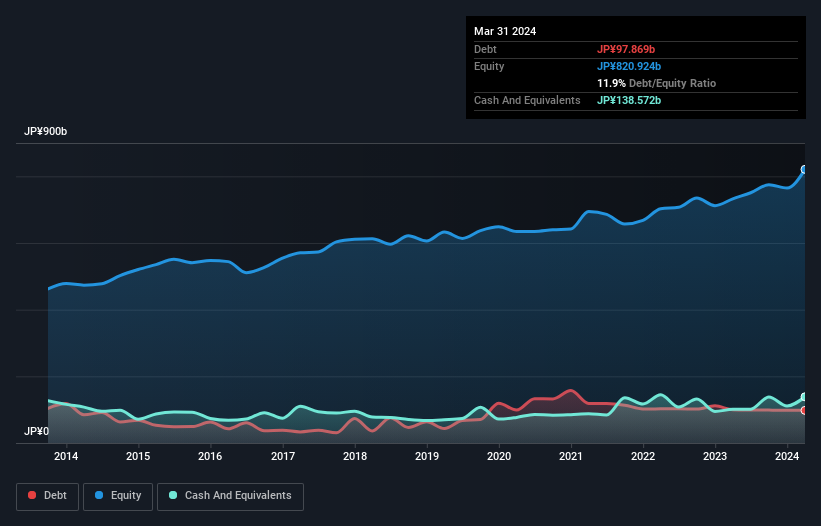- Japan
- /
- Industrials
- /
- TSE:4204
These 4 Measures Indicate That Sekisui Chemical (TSE:4204) Is Using Debt Reasonably Well

Warren Buffett famously said, 'Volatility is far from synonymous with risk.' So it seems the smart money knows that debt - which is usually involved in bankruptcies - is a very important factor, when you assess how risky a company is. Importantly, Sekisui Chemical Co., Ltd. (TSE:4204) does carry debt. But should shareholders be worried about its use of debt?
Why Does Debt Bring Risk?
Generally speaking, debt only becomes a real problem when a company can't easily pay it off, either by raising capital or with its own cash flow. Ultimately, if the company can't fulfill its legal obligations to repay debt, shareholders could walk away with nothing. However, a more usual (but still expensive) situation is where a company must dilute shareholders at a cheap share price simply to get debt under control. Of course, debt can be an important tool in businesses, particularly capital heavy businesses. The first thing to do when considering how much debt a business uses is to look at its cash and debt together.
Check out our latest analysis for Sekisui Chemical
What Is Sekisui Chemical's Net Debt?
As you can see below, Sekisui Chemical had JP¥97.9b of debt, at March 2024, which is about the same as the year before. You can click the chart for greater detail. However, it does have JP¥138.6b in cash offsetting this, leading to net cash of JP¥40.7b.

How Healthy Is Sekisui Chemical's Balance Sheet?
We can see from the most recent balance sheet that Sekisui Chemical had liabilities of JP¥344.6b falling due within a year, and liabilities of JP¥157.7b due beyond that. Offsetting this, it had JP¥138.6b in cash and JP¥212.3b in receivables that were due within 12 months. So it has liabilities totalling JP¥151.4b more than its cash and near-term receivables, combined.
Of course, Sekisui Chemical has a market capitalization of JP¥939.1b, so these liabilities are probably manageable. Having said that, it's clear that we should continue to monitor its balance sheet, lest it change for the worse. Despite its noteworthy liabilities, Sekisui Chemical boasts net cash, so it's fair to say it does not have a heavy debt load!
The good news is that Sekisui Chemical has increased its EBIT by 3.0% over twelve months, which should ease any concerns about debt repayment. The balance sheet is clearly the area to focus on when you are analysing debt. But it is future earnings, more than anything, that will determine Sekisui Chemical's ability to maintain a healthy balance sheet going forward. So if you want to see what the professionals think, you might find this free report on analyst profit forecasts to be interesting.
But our final consideration is also important, because a company cannot pay debt with paper profits; it needs cold hard cash. While Sekisui Chemical has net cash on its balance sheet, it's still worth taking a look at its ability to convert earnings before interest and tax (EBIT) to free cash flow, to help us understand how quickly it is building (or eroding) that cash balance. In the last three years, Sekisui Chemical's free cash flow amounted to 45% of its EBIT, less than we'd expect. That's not great, when it comes to paying down debt.
Summing Up
While Sekisui Chemical does have more liabilities than liquid assets, it also has net cash of JP¥40.7b. And it also grew its EBIT by 3.0% over the last year. So we don't have any problem with Sekisui Chemical's use of debt. When analysing debt levels, the balance sheet is the obvious place to start. But ultimately, every company can contain risks that exist outside of the balance sheet. Case in point: We've spotted 1 warning sign for Sekisui Chemical you should be aware of.
At the end of the day, it's often better to focus on companies that are free from net debt. You can access our special list of such companies (all with a track record of profit growth). It's free.
New: Manage All Your Stock Portfolios in One Place
We've created the ultimate portfolio companion for stock investors, and it's free.
• Connect an unlimited number of Portfolios and see your total in one currency
• Be alerted to new Warning Signs or Risks via email or mobile
• Track the Fair Value of your stocks
Have feedback on this article? Concerned about the content? Get in touch with us directly. Alternatively, email editorial-team (at) simplywallst.com.
This article by Simply Wall St is general in nature. We provide commentary based on historical data and analyst forecasts only using an unbiased methodology and our articles are not intended to be financial advice. It does not constitute a recommendation to buy or sell any stock, and does not take account of your objectives, or your financial situation. We aim to bring you long-term focused analysis driven by fundamental data. Note that our analysis may not factor in the latest price-sensitive company announcements or qualitative material. Simply Wall St has no position in any stocks mentioned.
Have feedback on this article? Concerned about the content? Get in touch with us directly. Alternatively, email editorial-team@simplywallst.com
About TSE:4204
Sekisui Chemical
Engages in the housing, urban infrastructure and environmental products, high performance plastics, and medical businesses.
Flawless balance sheet with proven track record and pays a dividend.
Similar Companies
Market Insights
Community Narratives



